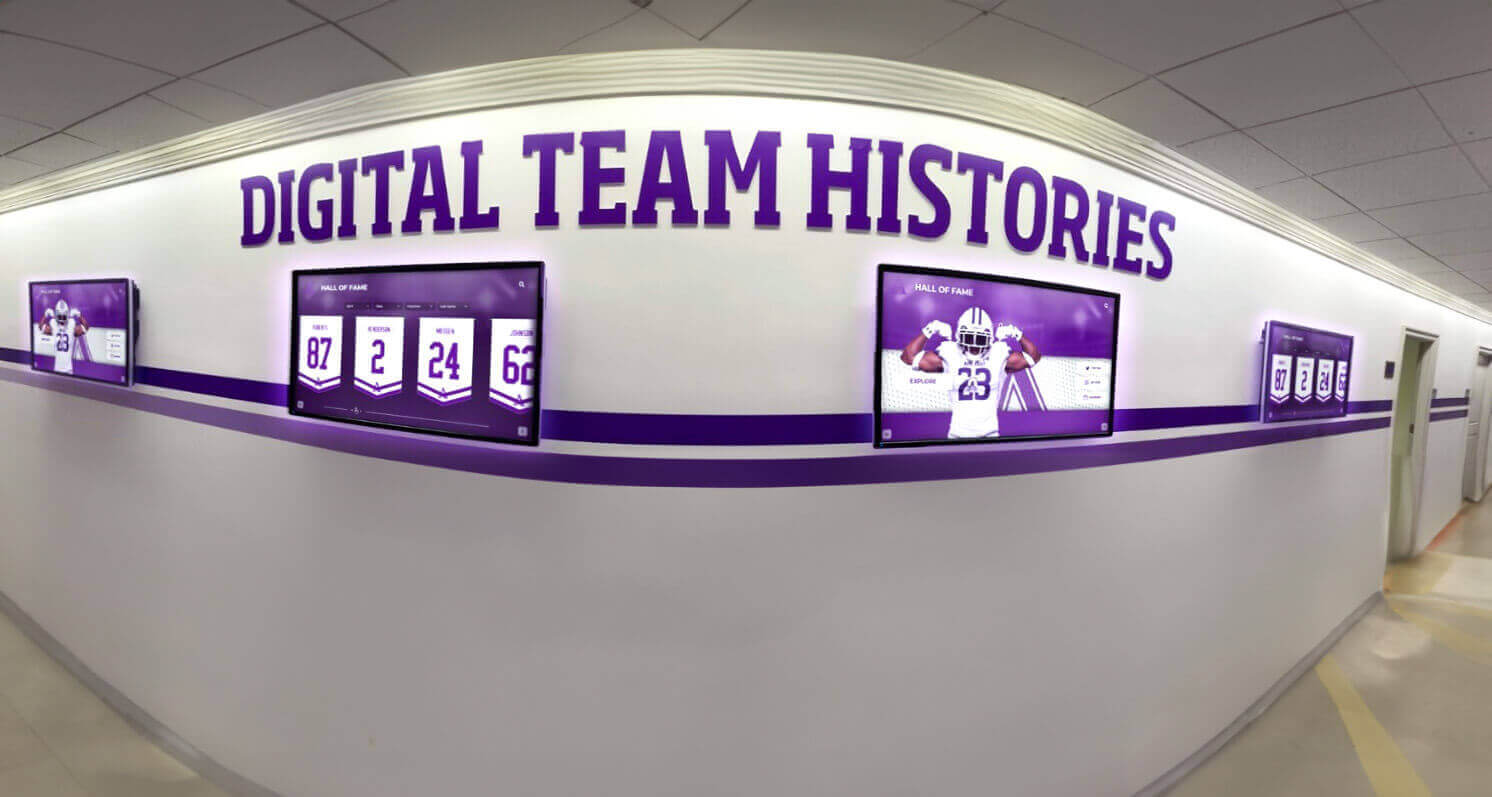College athletics encompasses far more than the marquee sports that fill stadiums—it represents a comprehensive ecosystem where student-athletes across dozens of sports pursue excellence while balancing academic commitments, personal growth, and competitive achievement. Hall of fame programs that recognize this full spectrum of athletic accomplishment serve as powerful tools for celebrating tradition, inspiring current athletes, and strengthening institutional pride across all sports.
Whether you’re an athletic director planning a new comprehensive recognition program, a sports information director managing existing displays, or a facilities coordinator evaluating recognition solutions, this guide provides practical strategies for creating meaningful college athletics hall of fame experiences that serve your entire athletic community.
Understanding Comprehensive Athletics Hall of Fame Programs
College athletics hall of fame programs differ from sport-specific recognition by embracing the full breadth of institutional athletic achievement across all competitive programs.
Beyond Revenue Sports: The Case for Comprehensive Recognition
Many universities maintain separate hall of fame programs for revenue sports like football and basketball while offering limited or no formal recognition for Olympic sports, women’s programs, and other athletic achievements. While sport-specific programs certainly have merit, comprehensive athletics hall of fame programs provide significant advantages.
Comprehensive programs demonstrate institutional commitment to all student-athletes regardless of sport profile. They address Title IX considerations by ensuring equitable recognition for women’s and men’s programs. They celebrate diverse forms of athletic excellence from team championships to individual national titles. They honor coaches, trainers, and administrators who impact multiple sports. And they strengthen alumni engagement across broader constituencies than single-sport programs reach.

Athletics departments increasingly recognize that equitable recognition matters deeply to athletes, coaches, and supporters of programs beyond the revenue sports. A volleyball player who earned All-American honors or a track athlete who set conference records deserves recognition alongside football stars, and comprehensive hall of fame programs deliver this inclusive celebration.
Levels of Athletics Hall of Fame Recognition
College athletics hall of fame programs typically exist at multiple organizational levels, each serving distinct purposes.
Institutional athletics halls of fame recognize the greatest athletes, teams, and contributors from all sports within a single university’s programs. These school-specific halls celebrate individuals whose achievements proved exceptional within their institutional context, regardless of whether they achieved national prominence.
Conference hall of fame programs honor outstanding performers across member institutions. The Ivy League Athletics Hall of Fame, for example, recognizes exceptional athletes from all sports across its eight member schools. These multi-institutional programs celebrate excellence at the conference level while acknowledging that not all outstanding performers reach national recognition.
National governing body halls of fame operated by organizations like the National Association of Collegiate Directors of Athletics (NACDA) or sport-specific national organizations recognize individuals who achieved excellence at the highest levels of collegiate competition across institutions nationwide.
This guide focuses primarily on institutional athletics hall of fame programs, as these represent the most common and impactful recognition systems for individual universities and colleges.
Core Objectives of Athletics Hall of Fame Programs
Effective athletics hall of fame programs serve multiple strategic purposes that extend beyond simple recognition. They preserve institutional athletic history across all programs, documenting achievements that might otherwise be forgotten as decades pass. They inspire current student-athletes by showcasing tangible examples of what excellence looks like in their specific sports. They strengthen alumni connections across multiple sports and eras, creating shared institutional identity.
These programs also support recruiting efforts by demonstrating program tradition and commitment to honoring achievement. They enhance fundraising initiatives by engaging alumni through recognition and celebration. And they promote school pride among current students, faculty, staff, and the broader community.
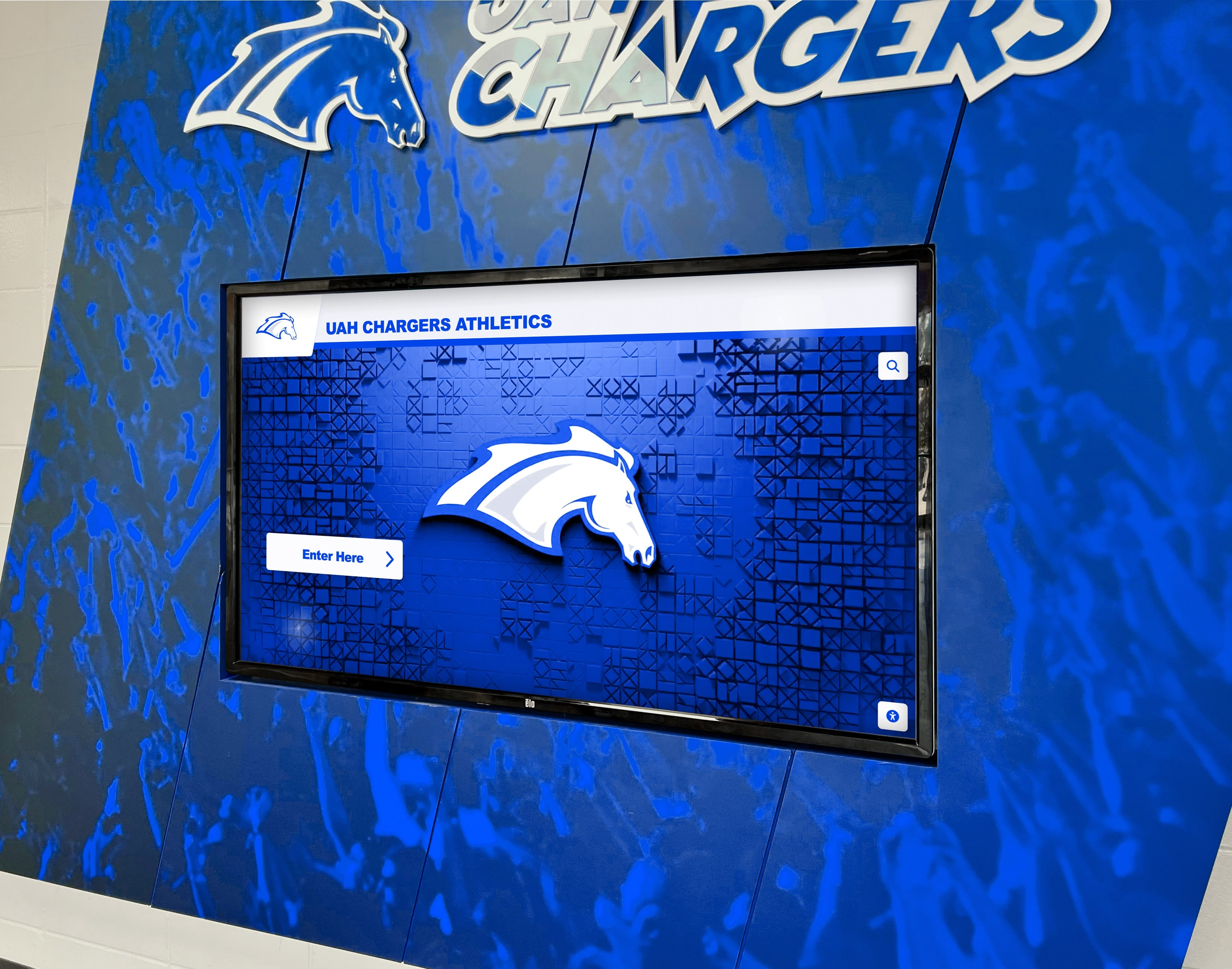
Understanding these objectives helps guide decisions throughout program development. The most successful athletics hall of fame programs keep these strategic goals central to all design and implementation choices.
Developing Inclusive Selection Criteria
Establishing fair, transparent selection criteria proves essential for maintaining program credibility and ensuring comprehensive recognition across all sports.
Balancing Sport-Specific and Universal Standards
One of the most challenging aspects of comprehensive athletics hall of fame programs involves creating selection criteria that work equitably across vastly different sports. Comparing achievement levels between sports requires thoughtful consideration.
Most successful programs establish universal baseline criteria that apply regardless of sport. These typically include graduation from the institution, a minimum time period since completing eligibility (commonly 10-15 years), embodiment of institutional values and sportsmanship, and significant competitive achievement relative to sport-specific standards.
The competitive achievement component necessarily varies by sport. National championship in team sports, individual national championships or All-American honors in individual sports, conference championships and conference player of the year recognition, Olympic or world championship participation, and professional career success at the highest levels all represent forms of exceptional achievement, though specific standards differ across sports.
Creating sport-specific achievement thresholds that maintain consistent prestige levels across programs ensures that a soccer All-American and a swimming All-American face comparably rigorous standards, even though their sports operate within different competitive structures.
Multi-Dimensional Evaluation Criteria
Beyond competitive achievement, comprehensive evaluation considers multiple dimensions that provide fuller pictures of candidates’ contributions and character.
Athletic achievement naturally receives primary consideration, but most programs also evaluate academic success during the student-athlete’s collegiate career. Leadership demonstrated both during and after college years matters significantly. Community service and civic engagement show impact beyond athletics. Professional accomplishments in post-college careers demonstrate sustained excellence. And contributions back to the institution or athletic programs indicate ongoing commitment.
These multi-dimensional criteria recognize that the most deserving hall of fame inductees typically excel across multiple areas, embodying the student-athlete ideal rather than simply achieving athletic success.
Creating Recognition Categories and Tiers
Many comprehensive athletics hall of fame programs establish multiple recognition categories to honor different types of contributions. Common categories include student-athlete inductees who competed in institutional athletic programs, coaches who led teams to significant success, administrators and staff who built programs or created conditions for success, teams that achieved championship success or significant milestones, and special contributors including trainers, physicians, donors, and others whose support proved essential.
Some programs also create tiered recognition systems. A highest honor tier might recognize national champions, Olympians, and All-Americans. A broader athletic achievement tier could honor all-conference performers and significant contributors. Special recognition categories might celebrate longevity, character, or specific program milestones.
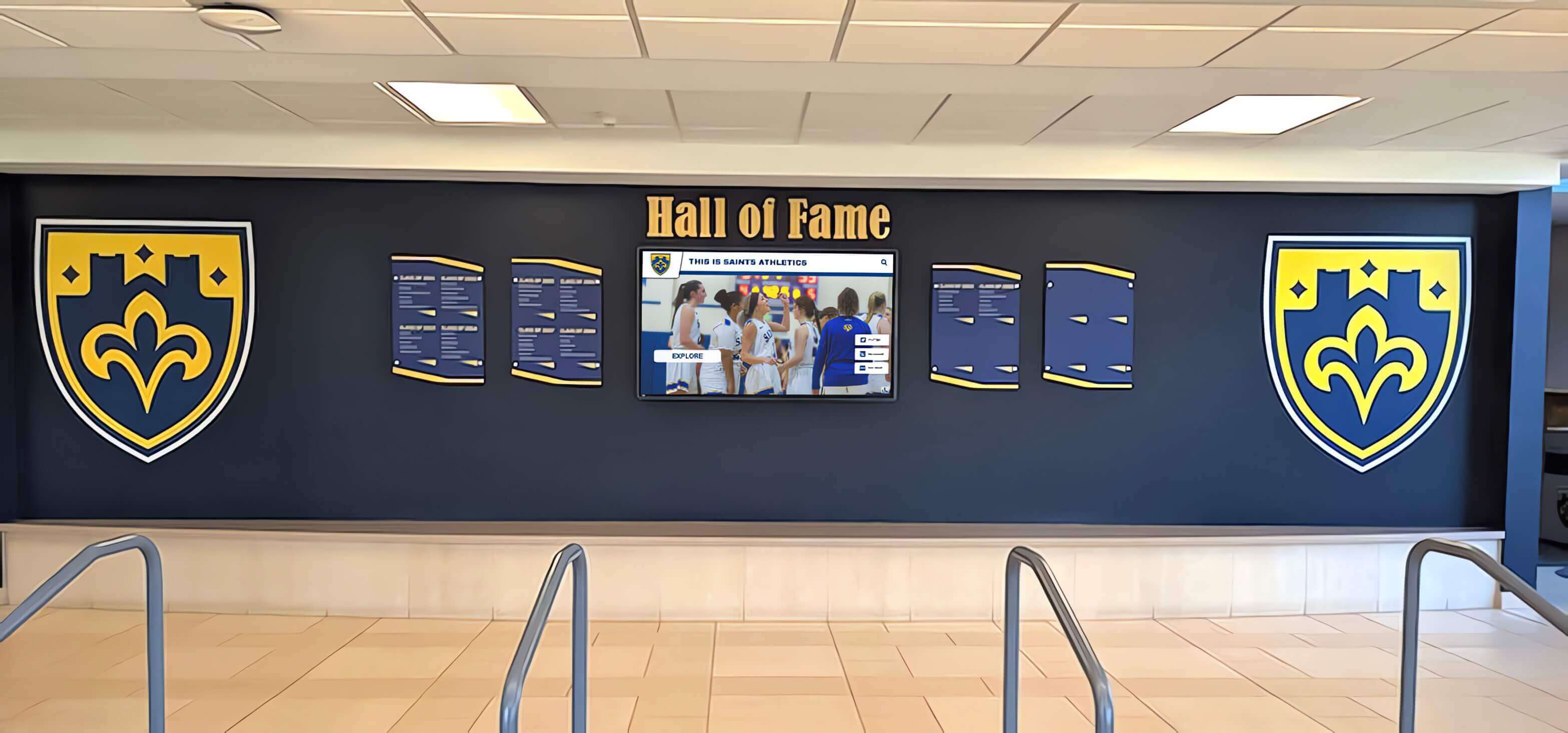
Clear category definitions prevent awkward comparisons—you’re not directly comparing a national champion wrestler to a dedicated athletic trainer, but rather honoring each within appropriate recognition frameworks.
Selection Committee Structure and Process
Effective selection processes rely on diverse committee representation and transparent procedures. Selection committees should include athletic administrators representing different program areas, former student-athletes from various sports and eras, faculty athletics representatives ensuring academic standards, alumni association leadership connecting to broader constituencies, and sometimes emeritus coaches or community representatives.
This diversity ensures that all sports receive fair consideration and that committee membership doesn’t overweight revenue sports or specific eras.
Most committees operate on annual cycles with designated nomination periods when constituencies can submit candidates, committee review sessions examining nominations against established criteria, voting processes determining inductees, and public announcements celebrating selections. Documenting these processes transparently on athletic department websites helps manage expectations and demonstrates fairness.
Traditional Display Approaches for Athletics Recognition
Traditional physical displays have long served as the standard for athletics hall of fame recognition, taking various forms depending on institutional preferences and available spaces.
Wall-Mounted Recognition Systems
The classic athletics hall of fame approach features wall-mounted displays in athletic facilities, typically including individual plaques for each inductee, team recognition for championship squads, retired jersey displays for exceptional performers, and timeline exhibits documenting program history.
These traditional installations provide timeless visual presence and create inspiring spaces that student-athletes pass daily. The physical permanence communicates lasting institutional commitment to recognition.
However, traditional displays face significant practical limitations. Physical space constraints ultimately limit how many individuals can be honored as programs mature over decades. Updates and additions require expensive fabrication and installation. Content limitations mean only brief information fits on physical plaques. And accessibility challenges arise when displays occupy single locations that may not be convenient for all visitors.
Many athletics departments appreciate traditional aesthetics but find that space limitations eventually force difficult decisions about who receives physical recognition and who doesn’t—particularly problematic for comprehensive programs honoring athletes across many sports.
Physical Trophy Cases and Memorabilia Galleries
Beyond individual plaques, many athletics programs create comprehensive displays featuring championship trophies spanning multiple sports, game-worn uniforms and equipment, signed memorabilia from notable athletes, historical photographs documenting program evolution, and newspaper clippings and media coverage of significant achievements.
These tactile exhibits create powerful emotional connections, particularly for alumni who experienced these achievements personally. Traditional trophy cases provide excellent visibility for select items.

However, physical capacity limitations force difficult decisions about what receives display space. Valuable memorabilia often remains in storage rather than visible to visitors. When programs span dozens of sports accumulated over many decades, traditional display space cannot possibly accommodate comprehensive representation.
Dedicated Hall of Fame Facilities
Some universities with extensive athletic traditions create dedicated hall of fame facilities or galleries. These spaces might span hundreds or thousands of square feet, incorporating multiple display types, video viewing areas, interactive exhibits, and special event capabilities.
Dedicated facilities provide immersive recognition experiences and become destinations for recruits, donors, and alumni. They can accommodate comprehensive collections in ways that hallway displays cannot.
The significant facility investment required means this approach typically suits institutions with major athletic programs and substantial budgets. Most institutions lack both physical space and financial resources for standalone athletics hall of fame buildings, necessitating creative approaches that achieve recognition goals within realistic constraints.
Modern Digital Recognition Solutions for Athletics Programs
Digital recognition technology transforms comprehensive athletics hall of fame programs by eliminating space constraints, enabling rich multimedia storytelling, and providing engagement capabilities traditional displays cannot match.
Interactive Touchscreen Display Systems
Digital hall of fame displays utilize large touchscreen technology to create engaging experiences where visitors actively explore athlete profiles, team championships, coaching histories, and program milestones across all sports.
These systems typically feature commercial-grade touchscreen displays ranging from 55 to 75 inches, cloud-based content management systems enabling easy updates, searchable databases allowing visitors to find athletes by name, sport, era, or achievement category, and multimedia content including photos, videos, statistics, and detailed narratives.
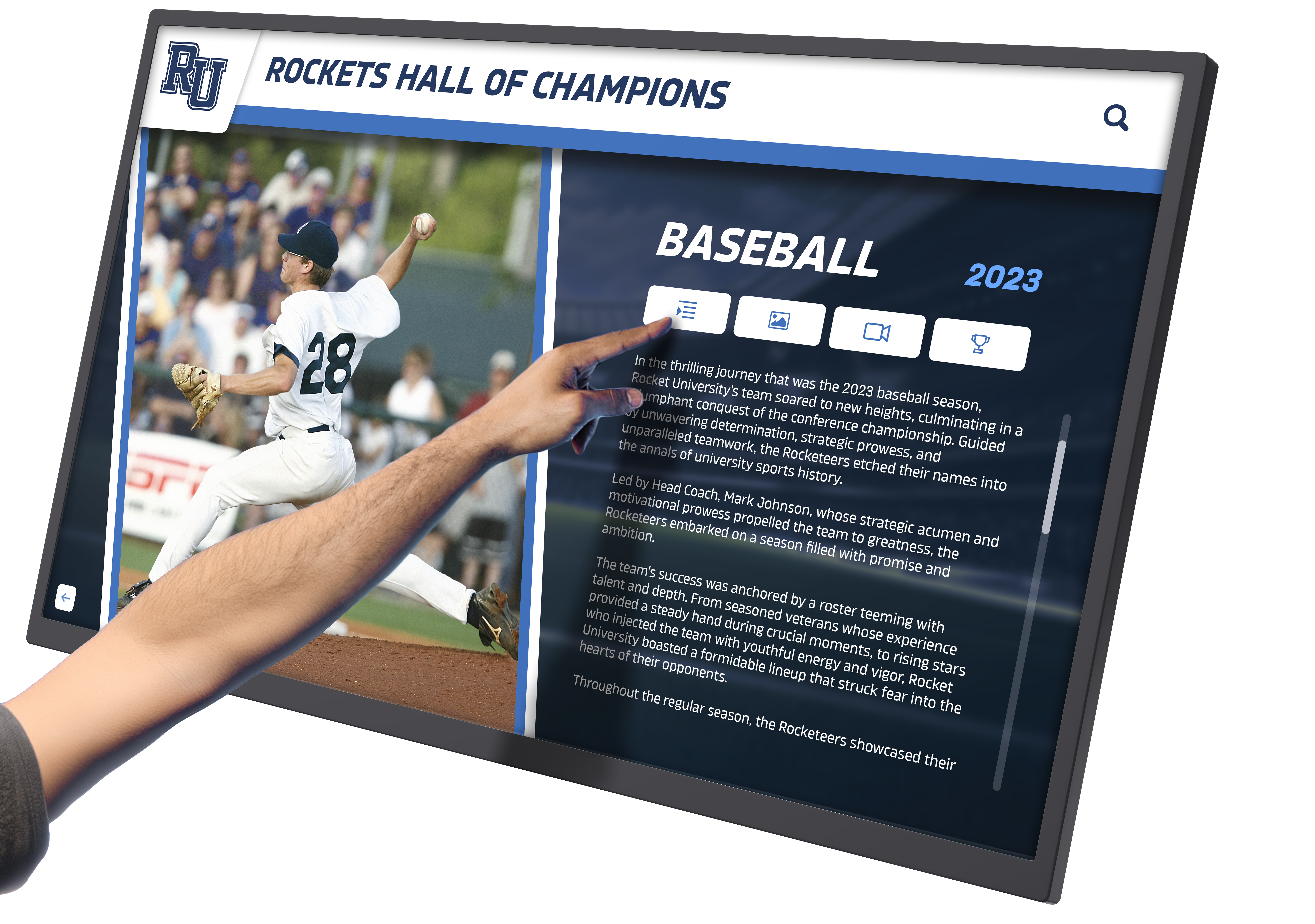
The advantages over traditional displays prove substantial for comprehensive athletics programs. Unlimited capacity means every deserving athlete across all sports receives recognition without space constraints. Instant updates through software rather than physical construction allow timely recognition of new inductees. Rich storytelling through video highlights, extended biographies, and photo galleries brings achievements to life across diverse sports. Advanced search functions help visitors quickly locate athletes by sport, graduating class, or achievement type. And engagement analytics reveal how visitors interact with content across different sports.
Solutions like Rocket Alumni Solutions provide purpose-built platforms specifically designed for educational and athletic recognition, addressing the unique needs of comprehensive college athletics programs. Unlike generic digital signage systems, these specialized solutions include features specifically relevant to athletics recognition including sport-specific categorization, statistical integration, team roster displays, and championship season documentation.
Online and Mobile Hall of Fame Platforms
Digital recognition extends beyond physical displays through web-based hall of fame platforms accessible worldwide. Online platforms enable alumni anywhere to explore hall of fame content across all sports, social sharing that amplifies recognition reach, integration with athletic fundraising and engagement systems, mobile accessibility for visitors during campus and facility tours, and preservation of historical content in formats more durable than physical artifacts.
Many programs implement hybrid approaches combining physical touchscreen installations in athletic facilities with online companion platforms accessible globally. This omnichannel strategy maximizes both on-campus impact and worldwide alumni engagement across all sports programs.
For comprehensive athletics programs, online platforms prove particularly valuable because they remove physical location constraints. An Olympic sport athlete who wants to explore fellow sport participants can do so easily through filtering and search features, even if their sport occupies less physical prominence than revenue sports in traditional displays.
Sport-Specific and Cross-Sport Navigation Features
One of the most powerful advantages of digital athletics hall of fame platforms involves sophisticated navigation enabling both sport-specific exploration and cross-sport discovery. Visitors can filter inductees by specific sport, browse by decade or era, search by achievement type such as All-Americans or Olympians, explore team championship seasons, or discover cross-sport patterns like multi-sport athletes.
This flexibility serves diverse audiences effectively. A former swimming team member visiting campus might filter specifically for swimming and diving inductees. A prospective recruit on a facility tour might explore inductees in their specific sport to understand program tradition. A researcher studying institutional athletic history might examine patterns across all sports and eras.
Traditional physical displays cannot provide this sophisticated, personalized navigation—everyone sees the same linear presentation. Digital platforms adapt to each visitor’s interests, creating more engaging experiences across diverse constituencies.
Content Development for Comprehensive Athletics Programs
Regardless of display format, compelling content determines whether hall of fame programs achieve their potential to inspire, educate, and engage across all sports.
Athlete Profile Structure and Depth
Comprehensive athlete profiles should include essential information along with narrative elements that tell complete stories across the full spectrum of sports. Standard elements include full name and sport(s) participated in, years of competition and graduating class, position or event specialty, career statistics and records, championships and postseason achievements, academic honors and degree earned, All-Conference, All-Region, and All-American selections, and post-college career highlights including professional sports or other accomplishments.
Beyond these basics, engaging profiles incorporate narrative elements that humanize achievements across all sports. What path led them to their sport and institution? What obstacles did they overcome during their collegiate career? How did their experience as a student-athlete shape their life trajectory? What do teammates and coaches remember most? What advice would they offer current student-athletes in their sport? What impact has their success created beyond personal achievement?

Digital platforms accommodate extensive content impossible to fit on physical plaques, enabling storytelling depth that creates meaningful connections across all sports. A field hockey player can receive equally comprehensive recognition as a basketball player, addressing the equity concerns that often plague traditional space-limited displays.
Multimedia Content Collection Across All Sports
Digital recognition programs benefit enormously from rich multimedia content that brings achievements to life across all sports. High-quality photographs from competition, training, and ceremonial moments create visual interest. Video highlights showcase athletic excellence in action—particularly valuable for Olympic sports that receive less media coverage. Audio interviews with inductees provide personal perspectives and voices. Historical newspaper clippings and media guides document achievements in contemporary contexts. And photo galleries showing athletes from recruitment through competition and beyond humanize athletic journeys.
Collecting this content requires systematic outreach including detailed questionnaires to inductees requesting photos and memorabilia, video interview sessions that can occur during induction ceremonies or alumni events, searches through institutional archives and sports information department records, requests to family members who often possess personal materials, and coordination with professional leagues if athletes advanced beyond college.
The content collection investment proves particularly worthwhile for comprehensive athletics programs because it ensures equitable treatment across all sports. With dedicated effort, a lacrosse player can receive equally rich multimedia recognition as a football player, creating the inclusive recognition environment that comprehensive programs aspire to deliver.
Team and Championship Season Recognition
Beyond individual athlete profiles, effective comprehensive athletics hall of fame programs celebrate team achievements across all sports. Championship season profiles might include complete team rosters with links to individual inductee profiles where applicable, season records and playoff results, coaching staff recognition, key game highlights and significant victories, statistical leaders across various categories, and historical context about the championship’s significance.

Creating comprehensive team profiles allows athletics programs to celebrate collective success while connecting team achievements to individual contributors. A visitor exploring a conference championship volleyball team might discover individual players they didn’t know also achieved All-American honors, creating richer understanding of program excellence.
Coaching and Administrator Recognition Content
Comprehensive athletics hall of fame programs extend beyond student-athletes to recognize exceptional coaches, administrators, trainers, and other contributors who enabled athletic success across multiple sports.
Coaching profiles should include win-loss records and championships, years of service and teams coached, athlete development and players who advanced to higher levels, program building and long-term impact on institutional athletics, innovation and contributions to sport development, and character and mentorship that shaped student-athlete lives beyond competition.
Administrator and contributor recognition might celebrate athletic directors who built comprehensive programs, sports medicine professionals who advanced athlete health and safety, academic support staff who enabled student-athlete success, facilities and operations staff who created conditions for competition, fundraising and development professionals who built resources, and donors whose support enabled program growth.
These recognition categories acknowledge that athletic success depends on far more than athletes and coaches—comprehensive programs honor all contributors who build excellence.
Implementation Strategies for Athletics Hall of Fame Programs
Successfully launching or revitalizing comprehensive college athletics hall of fame programs requires systematic planning addressing multiple dimensions.
Establishing Founding Inductee Classes
Programs beginning new hall of fame initiatives or significantly expanding existing programs face decisions about how to handle historical recognition. Many successful programs establish special founding classes or catchup phases that recognize deserving individuals from past decades who meet current selection criteria.
Founding class approaches might include establishing multiple inaugural classes over several years to avoid overwhelming recognition in year one, creating decade-specific cohorts such as 1960s, 1970s, 1980s classes, prioritizing the most exceptional historical figures first with plans to expand over time, or implementing special nomination processes for historical candidates where traditional records may be incomplete.
The founding class approach acknowledges that an athletics program beginning formal hall of fame recognition in 2025 has decades of prior achievement deserving recognition. Systematic historical recognition prevents the perception that only recent achievement matters while building comprehensive archives of institutional athletic excellence.
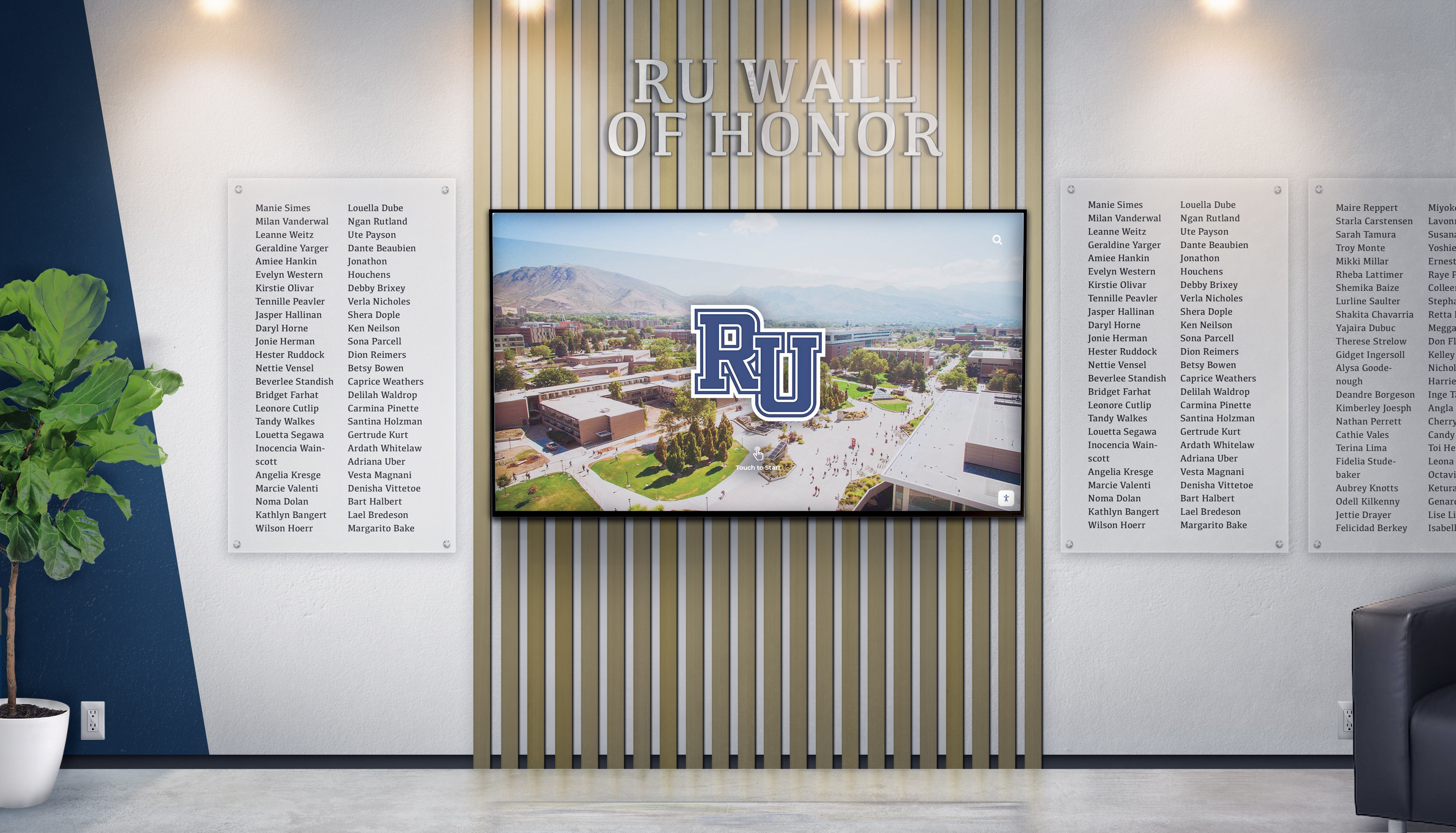
Budgeting and Funding Comprehensive Programs
Athletics hall of fame program costs vary dramatically based on scope and approach. Initial investments might include physical display construction or digital system implementation ranging from $15,000 to $50,000+ for comprehensive digital platforms, initial content development including research, writing, photography, and media production, marketing and launch event expenses, and committee operations and administrative support.
Ongoing expenses include annual induction ceremony costs, periodic content updates and new inductee additions, display maintenance whether traditional or digital, software licensing and support for digital systems, and communications and promotion across multiple sports communities.
Funding strategies for comprehensive athletics programs often include athletic department operating budget allocations, dedicated fundraising campaigns positioning the hall of fame as a giving opportunity, corporate sponsorships from local or national businesses wanting athletic affiliation, sport-specific fundraising where individual sport teams or alumni groups support content development, and inductee contributions where honorees make donations supporting program operations.
Framing the hall of fame as an investment in tradition, recruiting, and alumni engagement across all sports often proves more successful than requesting one-time project funding. The ongoing benefits justify sustained budget commitments.
Location and Visibility Planning
Hall of fame display location significantly impacts effectiveness, particularly for comprehensive programs seeking to serve all sports equitably. Ideal locations provide high visibility to multiple audiences including current student-athletes, recruits and their families, alumni and donors, and general campus visitors. They offer symbolic significance within athletic facilities, adequate space for comfortable viewing and interaction, and appropriate environmental conditions.
Common successful locations for comprehensive athletics hall of fame displays include athletic complex main lobbies serving multiple sports, hallways or concourses with high foot traffic, combined academic-athletic facilities demonstrating student-athlete excellence, dedicated athletic heritage rooms or galleries, and strategic positions visible during facility tours.
For digital displays, ensure locations provide necessary infrastructure including reliable electrical power, network connectivity for content updates and cloud-based systems, adequate lighting control to prevent screen glare, and appropriate mounting surfaces or floor space.
Some comprehensive programs implement multiple display locations—perhaps a primary installation in a central athletic facility with secondary displays in sport-specific venues. Digital platforms make this multi-location approach practical because the same content database populates all displays, ensuring consistent recognition without duplicate content development.
Ensuring Equity Across All Sports
Comprehensive athletics hall of fame programs must actively address equity considerations to ensure all sports receive appropriate recognition.
Title IX Considerations and Gender Equity
Title IX requires educational institutions to provide equitable athletic opportunities regardless of gender. While Title IX doesn’t explicitly mandate hall of fame recognition, the principles of equity certainly apply to celebration and recognition programs.
Athletics departments should periodically audit hall of fame recognition to ensure proportional representation across men’s and women’s programs. If your institution sponsors 10 men’s sports and 12 women’s sports, hall of fame representation should roughly reflect this distribution over time, accounting for program histories.
Similarly, selection criteria should be evaluated to ensure they don’t inadvertently favor sports with certain characteristics. If criteria emphasize professional sports success, they might favor sports with more established professional opportunities. If criteria heavily weight national championships, they might favor sports with NCAA championship structures over those with different governing bodies.
Regular equity audits and transparent reporting demonstrate institutional commitment to recognizing excellence across all student-athletes regardless of sport or gender.
Olympic Sports Recognition and Visibility
Olympic sports—those that don’t generate significant revenue but form the backbone of comprehensive athletics programs—often face visibility challenges in traditional recognition systems. Limited physical display space tends to favor high-profile sports, leaving Olympic sport achievements underrepresented.
Digital hall of fame platforms directly address this challenge. Unlimited capacity means track and field All-Americans receive equal profile depth as football All-Americans. Swimming and diving record boards can be comprehensively documented. Wrestling, gymnastics, tennis, golf, and all other sports receive recognition proportional to their achievements rather than their revenue generation.

Many Olympic sport athletes and alumni feel deep appreciation when their achievements receive visibility equal to revenue sports. This recognition strengthens alumni connections across broader constituencies and demonstrates institutional values that celebrate all forms of athletic excellence.
Emerging Sports and Program Evolution
Athletics programs evolve over time—sports are added, occasionally discontinued, and transition between competitive levels. Comprehensive hall of fame programs should accommodate this evolution while honoring all who competed under the institution’s banner.
Recognition programs might address discontinued sports through dedicated sections honoring athletes who competed before programs ended, historical context explaining program evolution, and memorial designations for sports no longer sponsored. These approaches honor past participants while acknowledging current program structures.
For newly added sports, hall of fame programs should welcome these athletes into recognition systems as they establish achievement records. Clear communication that new sports will receive equitable recognition helps build program culture from their founding.
Measuring Success and Program Impact
Evaluating comprehensive athletics hall of fame program effectiveness helps justify continued investment and identifies opportunities for enhancement across all sports.
Engagement Metrics and Analytics
Digital recognition systems provide valuable analytics including total visitor sessions, average interaction duration per session, most-viewed profiles revealing which sports and individuals attract greatest interest, search patterns showing how visitors explore content, sport-specific engagement comparing interaction across different sports, and peak usage times identifying when engagement occurs most.
This data informs content development priorities, reveals what resonates most with audiences across different sports, and demonstrates return on investment to stakeholders who approved program expenditures.
For comprehensive athletics programs, analytics can reveal whether all sports receive proportional interest or whether certain sports dominate engagement. This information might guide promotional strategies to build awareness of underutilized content.
Alumni Relations and Fundraising Impact
Hall of fame programs should contribute measurably to broader athletic department goals. Track metrics including alumni event attendance before and after implementation, giving participation rates from former student-athletes across all sports, major gift prospects cultivated through hall of fame connections, social media engagement with hall of fame content across different sports, and recruits mentioning tradition and legacy in commitment decisions.
While not all impact proves directly measurable, consistent qualitative feedback about increased pride and connection indicates program success even when quantitative metrics prove elusive.
Many athletics directors report that comprehensive recognition programs strengthen fundraising across all sports. When Olympic sport alumni see their achievements celebrated alongside revenue sports, they feel greater connection to institutional athletics and increased willingness to contribute financially.
Current Student-Athlete Influence
Perhaps most importantly, hall of fame programs should inspire current student-athletes across all sports to pursue excellence. Consider surveying current athletes about hall of fame awareness and impact on their motivation, monitoring academic performance and community service participation, tracking leadership development across teams, and gathering feedback from coaches about cultural impact.
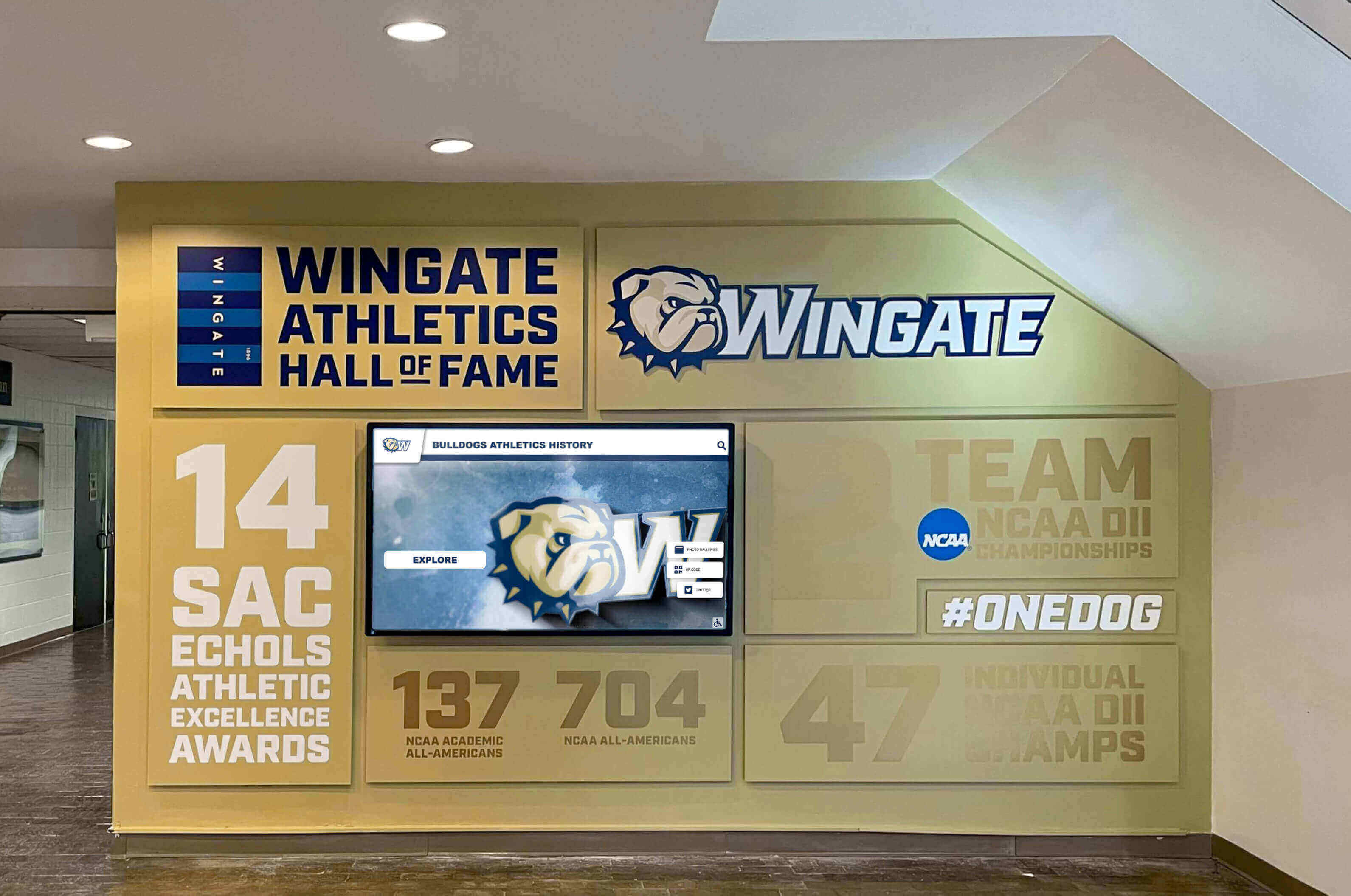
These indicators help assess whether recognition programs achieve their fundamental purpose of motivating current students while honoring past achievement across all athletic programs.
Integration with Recruiting and Development Efforts
Comprehensive athletics hall of fame programs serve strategic purposes beyond honoring past achievement when integrated effectively with recruiting and development initiatives.
Multi-Sport Recruiting Applications
Athletic recruiting depends increasingly on demonstrating program tradition and commitment to athlete development. Comprehensive hall of fame displays serve recruiting strategies across all sports by showcasing position-specific or event-specific legends to prospects, demonstrating pathways from collegiate to professional or Olympic competition, highlighting academic achievements of past athletes showing institutional commitment to student success, and celebrating conference championships and other achievements building program narrative.
Digital platforms make recruiting integration seamless across all sports. Recruiting coordinators in any sport can use touchscreen displays to highlight inductees relevant to prospects. A soccer recruit can explore soccer-specific hall of fame content without wading through football or basketball information. This sport-specific access creates more relevant recruiting experiences than traditional displays that present all sports together without sophisticated filtering.
Development and Fundraising Alignment
Development offices increasingly leverage recognition platforms in donor cultivation across all sports. Strategic integration includes featuring inductees at fundraising events and sport-specific campaigns, showcasing how donor support directly contributed to facilities, scholarships, and resources that enabled success, highlighting naming opportunities for specific components of recognition programs, and demonstrating institutional commitment to celebrating all contributors and achievements.
Development professionals working with Olympic sport constituents particularly appreciate comprehensive hall of fame programs because they provide tangible demonstration that the institution values these sports equally to revenue programs. This messaging proves essential when soliciting support from these alumni communities.
Special Considerations for Different Institutional Levels
College athletics programs vary dramatically across competitive divisions and institutional types. Recognition strategies should align with institutional realities.
Division I Programs with Comprehensive Athletic Departments
Large Division I programs with 20+ sports face both opportunities and challenges in comprehensive recognition. Opportunities include substantial inductee pools across many sports, existing media and communications infrastructure supporting content development, available budgets for comprehensive implementations, and high-profile visibility attracting attention.
Challenges include potential inductee backlogs if programs haven’t maintained consistent recognition across all sports, diverse constituencies with strong opinions about selection equity, high expectations for display quality and visitor experience, and need to balance revenue sports prominence with comprehensive recognition.
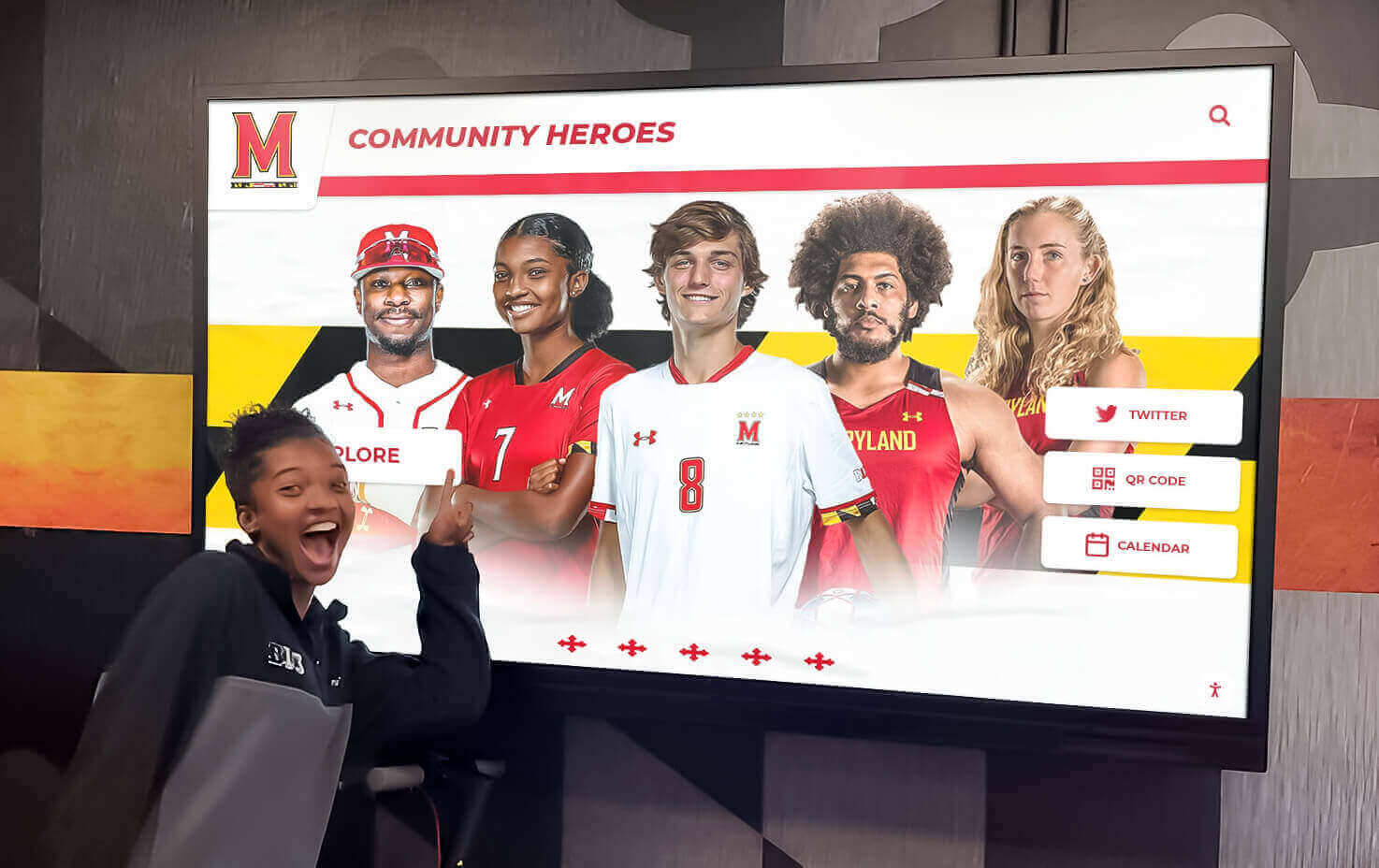
These programs often benefit most from comprehensive digital hall of fame systems that can accommodate large inductee collections across many sports while providing sophisticated features expected by major athletic departments.
Division II and III Programs
Division II and III institutions typically sponsor fewer sports with smaller budgets but often maintain passionate alumni communities across all sports. Success strategies for these levels include starting with focused scope recognizing true legends initially, planning phased expansion as resources allow, leveraging volunteer support from alumni for content development across all sports, emphasizing the student-athlete experience and academic achievement prominently, and considering scaled digital platforms appropriate to budget realities.
Appropriately scaled recognition approaches prove more sustainable than overextending limited budgets. Beginning with a modest but high-quality program creates foundation for growth rather than attempting comprehensive launches that strain resources.
NAIA and Junior College Programs
NAIA and junior college programs often punch above their weight in specific sports while maintaining comprehensive athletic programs. Recognition strategies for these institutions should emphasize unique program strengths and traditions, celebrate the specific characteristics of NAIA or junior college athletic experience, highlight transfer pathways and four-year outcomes for junior college programs, and build traditions systematically as programs evolve.
Digital-first approaches often work well for these programs because they scale naturally as traditions develop rather than requiring significant upfront physical construction investments.
Future Trends in Athletics Recognition Technology
Recognition technology continues evolving with emerging capabilities that will enhance comprehensive athletics hall of fame programs.
Enhanced Multimedia and Immersive Experiences
Expect continued innovation in content formats including 360-degree video allowing immersive experiences of competitions across all sports, virtual reality recreations of championship moments, augmented reality features overlaying digital content on physical spaces during facility tours, and AI-generated highlight compilations automatically created from historical footage.
These technologies will make historical achievements more accessible and engaging across all sports, particularly for younger audiences who connect readily with immersive digital experiences.
Social Integration and Community Content
Future systems will likely feature enhanced social connectivity allowing verified alumni to contribute memories, photos, and stories about teammates and opponents, automated social sharing optimized for various platforms and sports communities, community voting or input on special recognition categories, and live-streaming of induction ceremonies integrated with recognition platforms.
This participatory approach transforms hall of fame programs from top-down institutional initiatives into community-owned celebrations of shared athletic tradition across all sports.
Integration with Name, Image, and Likeness (NIL) Programs
Name, Image, and Likeness developments are changing college athletics fundamentally. Recognition platforms may increasingly integrate NIL compliance documentation and athlete branding tools, connect current athletes with hall of fame mentors in their sports, document NIL success stories alongside traditional achievements, and provide platforms for inducted athletes to share professional insights with current student-athletes.
These evolutions will position hall of fame programs as dynamic resources supporting current athletes while honoring past excellence across all sports.
Conclusion: Building Comprehensive Traditions That Honor All Athletes
College athletics hall of fame programs serve purposes far beyond simply displaying names on walls. Comprehensive programs that recognize excellence across all sports preserve institutional memory ensuring that extraordinary achievements remain visible to future generations regardless of sport profile. They strengthen alumni connections across diverse sports communities by demonstrating that all contributions matter. They inspire current student-athletes across all programs by showcasing concrete examples of excellence in their specific sports. And they support recruiting, development, and institutional pride by celebrating tradition and success throughout the athletic department.
Whether implemented through traditional physical displays, modern digital interactive systems, or hybrid approaches combining both elements, effective comprehensive athletics hall of fame programs require thoughtful planning, inclusive selection criteria addressing equity across all sports, compelling content development across diverse athletic achievements, appropriate technology enabling unlimited recognition, and sustained commitment to ongoing management and enhancement.
Programs that embrace comprehensive recognition—celebrating volleyball All-Americans alongside football legends, honoring swimming records with equal prominence to basketball championships, and recognizing the coaches, trainers, and administrators who build excellence across all programs—create inclusive recognition environments that serve entire athletic communities rather than privileged subsets.

For athletic departments ready to launch new comprehensive hall of fame programs or revitalize existing recognition systems to ensure equity across all sports, modern digital solutions provide practical approaches that solve space constraints, enable rich storytelling across diverse sports, create engaging experiences, and serve multiple strategic objectives from recruiting to fundraising across all athletic programs.
Ready to explore options for your college athletics hall of fame program? Whether starting from scratch or enhancing existing recognition to ensure comprehensive coverage across all sports, solutions like Rocket Alumni Solutions provide specialized support from planning through implementation and ongoing management. Discover how modern recognition technology can transform your institution’s ability to celebrate athletic excellence equitably across all sports while inspiring future champions in every program.
